Trying to squeeze in the highlights of Spain and Portugal into a two-week trip can be tricky. Both are incredible countries with rich culture, varied landscapes, vibrant cities, and architectural wonders. After traveling all over the Iberian Peninsula, I’ve come up with a route that hits every city efficiently and makes the most out of your time. This two-week Portugal and Spain itinerary will cover the must-see landmarks in each city, activity suggestions, restaurant and hotel recommendations, and my personal favorites.
As a Portuguese-American woman, I’ve visited these Portuguese cities countless times and, after living in Seville for four months and traveling the country, I have combined all of my favorite things into one trip. Plus, I’ve included hidden gems that most tourists would miss!
Best Times to Visit Spain and Portugal
The best time to visit Portugal and Spain is either early summer or fall. The months of May through early July are less busy than the following summer months. You’ll still get nice weather and less tourism around you. If you choose to visit in the fall, the weather will be just as good, and you’ll get to experience even less tourism. Keep in mind that summer in Southern Spain is incredibly hot and November and April are both rainy months in Portugal.

Portugal and Spain Itinerary Overview
This itinerary starts in Porto, Portugal and ends in Barcelona, Spain. You can also flip this itinerary if you prefer to visit Spain first!
- Days 1-2 in Porto, Portugal
- Douro River cruise and wine tasting
- Dinner and a view
- Livraria Lello and Majestic Cafe for Harry Potter lovers
- The Praça de Liberdade (Liberty Square)
- Michelin star restaurant
- Day 3 in Obidos, Portugal
- Medieval town
- Castle of Óbidos
- Pousada do Castelo de Óbidos hotel
- Nazare beach
- Days 4-6 in Lisbon/Sintra & Cascais (day trip), Portugal
- Commerce Square and Alfama
- Tuk Tuk tours
- Cable car
- Miradouro S. Luiza scenic spot
- Castelo S. Jorge
- 25 April Bridge
- Rossio Square
- Torre de Belém
- Sunset boat cruises on the Tagus River
- Fado show
- Pena Palace and the Quinta da Regaleira
- Cabo da Roca
- Days 7-8 in Algarve, Portugal
- Albufeira and Lagos
- Epic Sana Hotel or the Pine Cliff Resort
- Martinhal Sagres Family Resort
- Benagil Cave
- Vila Joya and Bon Bon fine dining
- Days 9-11 in Seville, Spain
- Hotel Alfonso XIII or Hotel Palacio de Villapanes
- El Centro
- Cathedral of Seville
- Royal Alcazar
- Setas de Seville
- Plaza de Espana & Maria Luisa Park
- La Carbonería
- Triana Market
- Paella cooking class
- Casa Manolo Lèon
- Days 12-14 in Barcelona/Montserrat (day trip), Spain
- Hotel Neri and Ohla
- Gothic Quarter
- Las Ramblas
- Gaudi houses
- Park Güell
- Sagrada Família
- Paella and Catalan dishes
- Montserrat mountains
This map was created using Google My Maps and covers my suggested Portugal and Spain itinerary. You can click on the star next to the title and save this to your Google Maps account or click on the share icon to send it to yourself via email.
14-Day Portugal and Spain Itinerary
Note: This post contains affiliate links. If you click a link and make a purchase, I may receive a small commission at no cost to you.
For this itinerary, I recommend that you fly into Porto and out of Barcelona (or vice versa). It may be easiest if you rent a car to drive from city to city, but if you want, you can take the train or bus from place to place and then fly from Seville to Barcelona. Keep in mind that parking in cities like Lisbon and Porto can be quite challenging, so you could also consider just picking up a rental car for a portion of your trip.
Day 1-2: Porto, Portugal
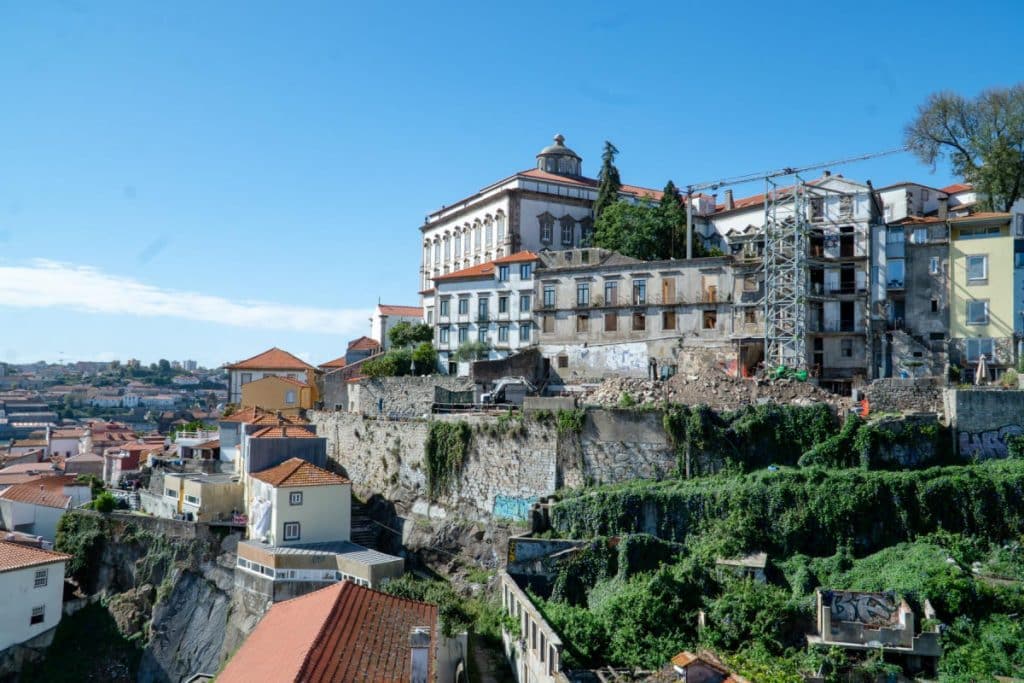
Once arriving in Porto, you should check into the PortoBay Flores Hotel or The Yeatman. Both are 5-star hotels but provide different experiences. PortoBay Flores is in the heart of Porto’s historic district. The hotel has an historic charm to it but still has plenty of modern luxuries, such as an indoor swimming pool. People who want to fully immerse themselves into the history and culture of Porto should stay here. The hotel is the perfect walking distance from plenty of landmarks such as Ribeira Square, the historical square of Porto.
The Yeatman Hotel is a luxury wine and spa hotel in the Vila Nova de Gaia historical district. For those who want to relax but also sightsee, this hotel is the best fit. You’re also able to have city views from the hotel of the famous Douro River.
If you are starting in Porto and arriving after an overnight flight, you will want to start off by exploring some of the city’s highlights on a self-guided walking tour. Begin by walking around and experiencing what Porto has to offer from stores, cafés to the historical districts.
Harry Potter fans and those with children, should visit Livraria Lello and Majestic Cafe. The Livraria Lello is the book store that gave J.K. Rowling inspirations for Harry Potter’s world, such as the moving staircases in Hogwarts. Majestic Cafe is where Rowling hung out and wrote.
The Praça de Liberdade (Liberty Square) is Porto’s main square that connects the old town with the modern part of the city and also a great place to walk around. Be sure to following the narrow streets down to the Douro River and cross over the Luis I Bridge to the Vila Nova de Gaia neighborhood where you can visit the World of Wine, sample some port, and enjoy the fun vibe along the riverfront.
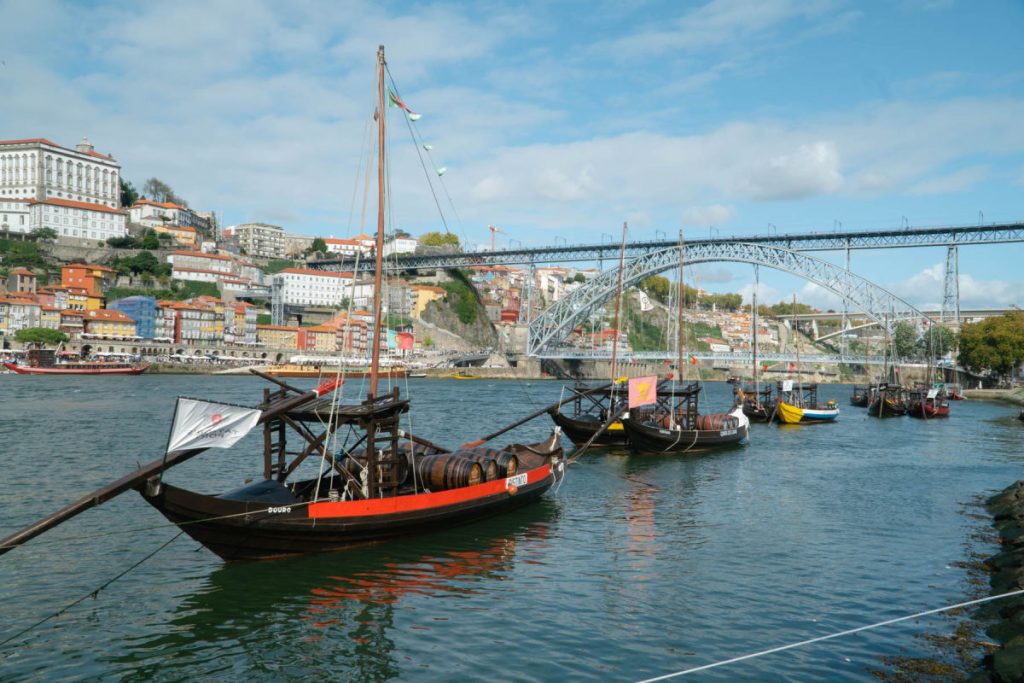
Finish up your first day with dinner at Terra Nora. Terra Nora is an intimate dining experience with traditional Portuguese cuisine. When making your reservation, request to sit at a window in order to see the Douro River as you dine. For sunset lovers, reserve a time a few minutes before it sets in order to see the sun set on the river.
For your second day, no trip to Porto is the same without doing a cruise or tour through the Douro Valley to see vineyards and breathtaking scenery. There are so many options, but I always prefer the tours that last all day for a full experience. The authentic Douro River tours last about 9 hours, including travel time to and from the Douro Valley.
The ideal Douro River excursion would include winery visits and tastings of both authentic Port wine and the other wines grown in the region. The wine tasting would then be followed by a cruise on the Douro River and ending with a typical Portuguese lunch made with Douro region products. If you don’t want to spend a full day in the Douro Valley, you can also take a cruise on the river in Porto on an authentic boat that used to carry wine barrels down the river.
For the final night in Porto a perfect meal is needed. For those staying in the Yeatman Hotel, there is a Michelin Star restaurant downstairs that has amazing reviews. Seafood lovers should make a reservation for the restaurant Gruta. After dinner, Porto nightlife is something you don’t want to miss out on. But don’t stay out too late as we prepare for a travel day tomorrow.
Day 3: Óbidos, Portugal
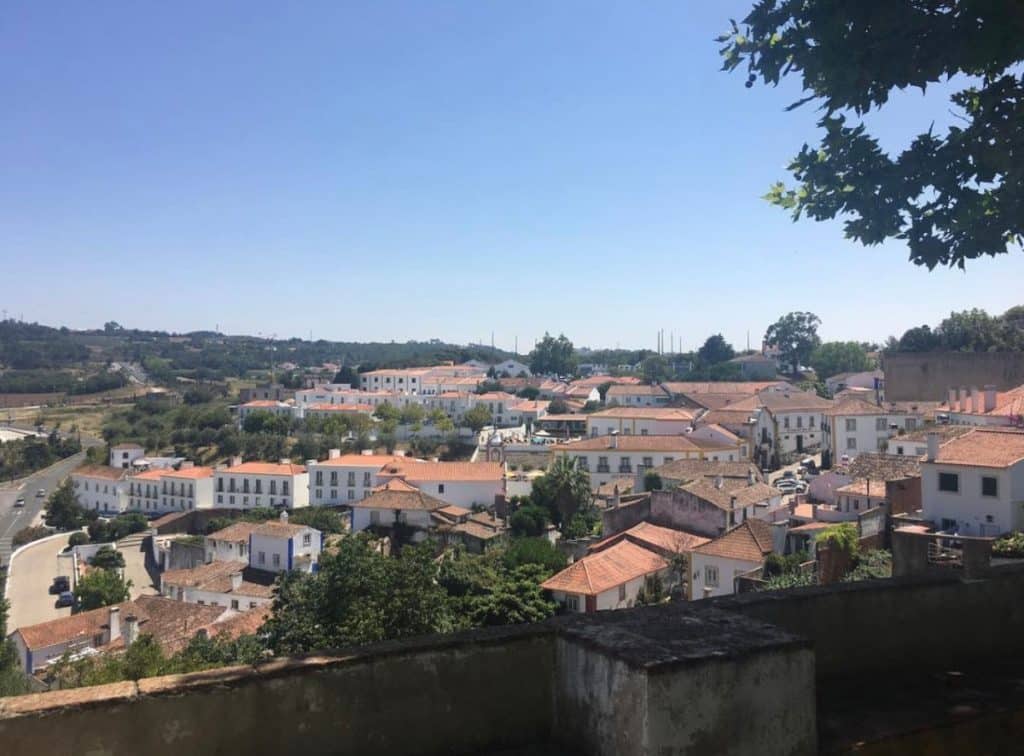
From Porto, you can travel to Óbidos by bus, train, or rental car. Óbidos is known for its medieval town surrounded by the Castle of Óbidos. For the one night you have here, stay at Pousada do Castelo de Óbidos hotel. The hotel is housed within the 12th-century medieval castle.
If you have a car, you can stop in Nazare on your way to Óbidos. Nazare’s beach is popular with surfers and known for its epically tall waves. Plus, there is a beautiful look-out point.
Days 4-6: Lisbon & Sintra, Portugal
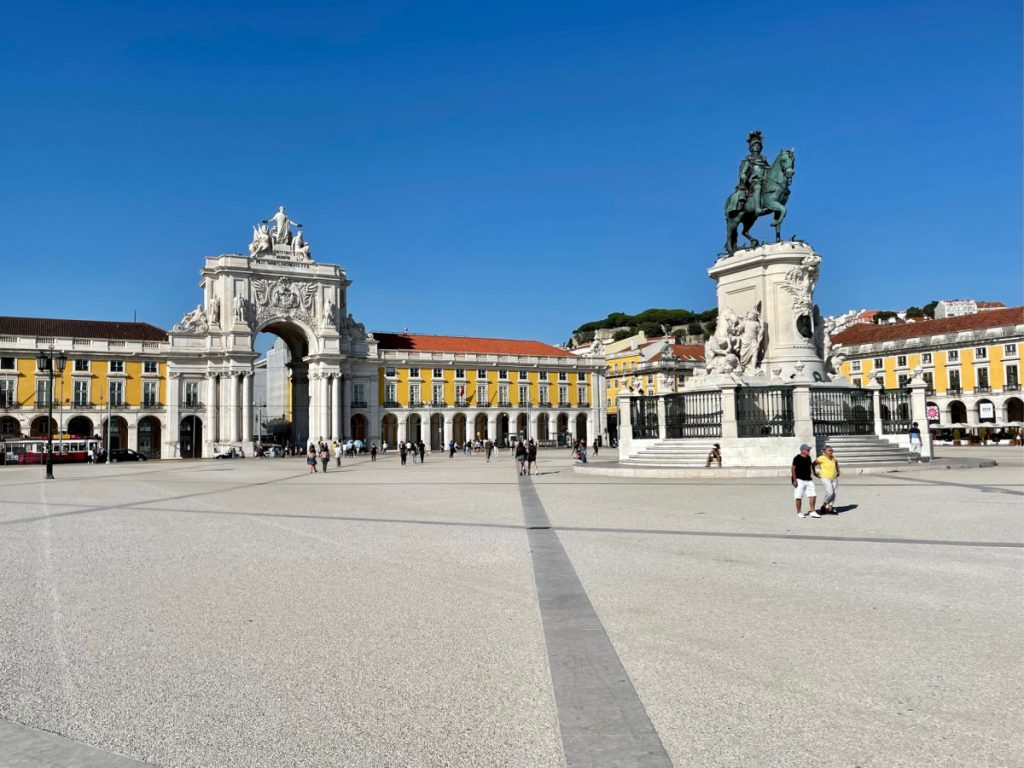
After your night in Óbidos, take a bus/train or drive to Lisbon. You should stay in the center of Lisbon by Commerce Square or the older part in Alfama. The Bairro Alto Hotel is a charming, centrally located stay that has a great restaurant within it. Another option is the Hotel Tivoli Avenida Liberdade Lisboa that is a large property out of the noisy city center on the tree-lined Avenida Liberdade.
The best way to see Lisbon is to just walk. Some streets are so narrow and steep that cars won’t fit through or get up. Lisbon’s infamous Tram 28 is a great tourist option to get explore the city. Tuk Tuk tours are also very popular for seeing Lisbon.
When going to popular scenic spots, it’s best to go early in the morning before 9:00 a.m. The Miradouro S. Luiza scenic spot has great views of Lisbon’s port and cathedral. It will be full of tourists the entire day, so get there early to get your picture.
Once you’ve gotten all your pictures, make your way to the Castelo S. Jorge that is only a five-minute walk away. The views from the castle are, in my opinion, the best it gets. You can see multiple landmarks such as the 25 April Bridge that was inspired by the Golden Gate Bridge as well as the Sanctuary of Christ monument.
For clothes, shoes, and trinket lovers; Rossio is a great shopping area with high-end stores. I highly recommend checking out shoe stores, any you can find around there are great quality and affordable. Once you get tired from shopping so much, take a quick walk to Rossio Square for a place to relax and people watch. Some alternative must see sights for the remainder days in Lisbon are; Commerce Square, Torre de Belém, and Jerónimos Monastery.
A sunset boat cruise on the Tagus River is my favorite activity to do in Lisbon by far. Nothing can beat being on a vintage sailboat with champagne in hand while eating Portuguese cheese and prosciutto. The sunset cruise I took was about two hours long, and I was able to sit right in the front of the boat on bean bag chairs while listening to the water and soft music.
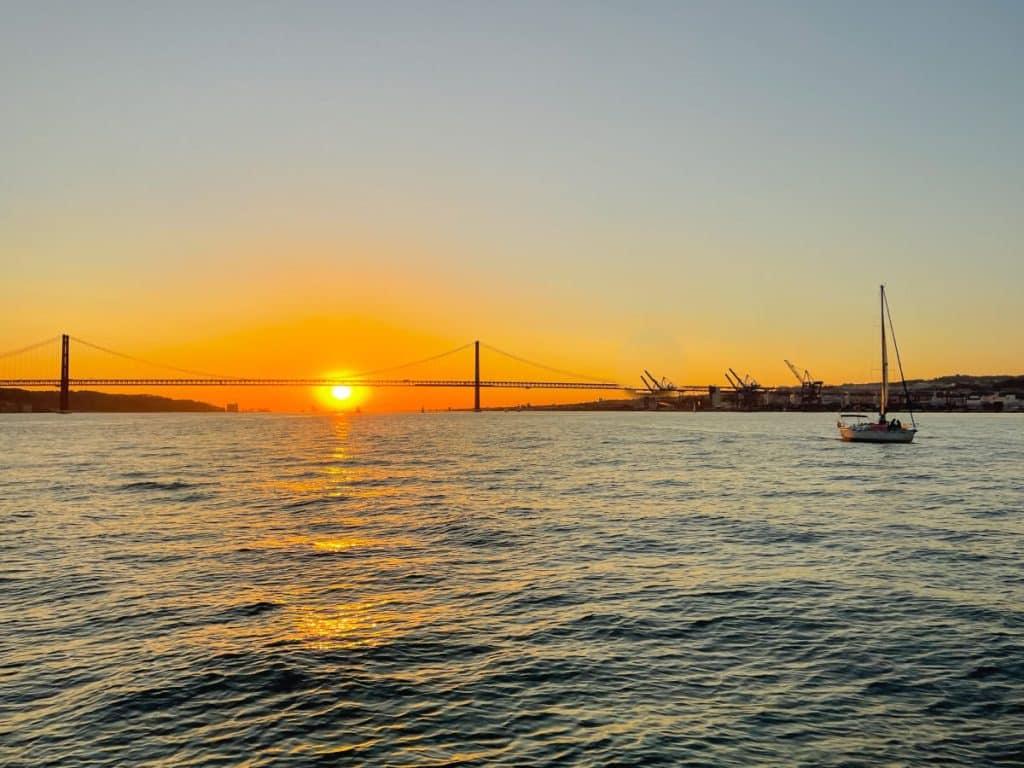
After the appetizers you consumed on the cruise, it’s now time for dinner. My top four restaurants in Lisbon are; BAHR, Alma, Solar dos Presuntos, and JNcQUOI Asia. All are traditional Portuguese dishes of meat and fish, except JNcQUOI Asia. Although I love Portuguese food, on this long of a trip I tend to want something different. JNcQUOI Asia offers four types of Asian cuisine: Indian, Thai, Chinese and Japanese.
Another option is to book a dinner and Fado show. Fado is a Portuguese music genre that consists of folk guitars, hand clapping, and singing. Parreirinha de Alfama is a small Portuguese restaurant that has Fado singing. The restaurant is very quaint in order for it to feel like a homespun restaurant. All the food is cooked in a tiny kitchen by one woman.
After spending a day or two in Lisbon, it’s worth making a day trip to Sintra and the seaside town of Cascais. Sintra is known for the Pena Palace and the Quinta da Regaleira. The town is very small and can be seen in a few hours. On the way back from Sintra, make a stop in Cascais for the Cabo da Roca which is the cape of Portugal and the most western part of Europe.
For more suggestions, see my 3 Day Lisbon Itinerary.
Days 7-8: Algarve, Portugal
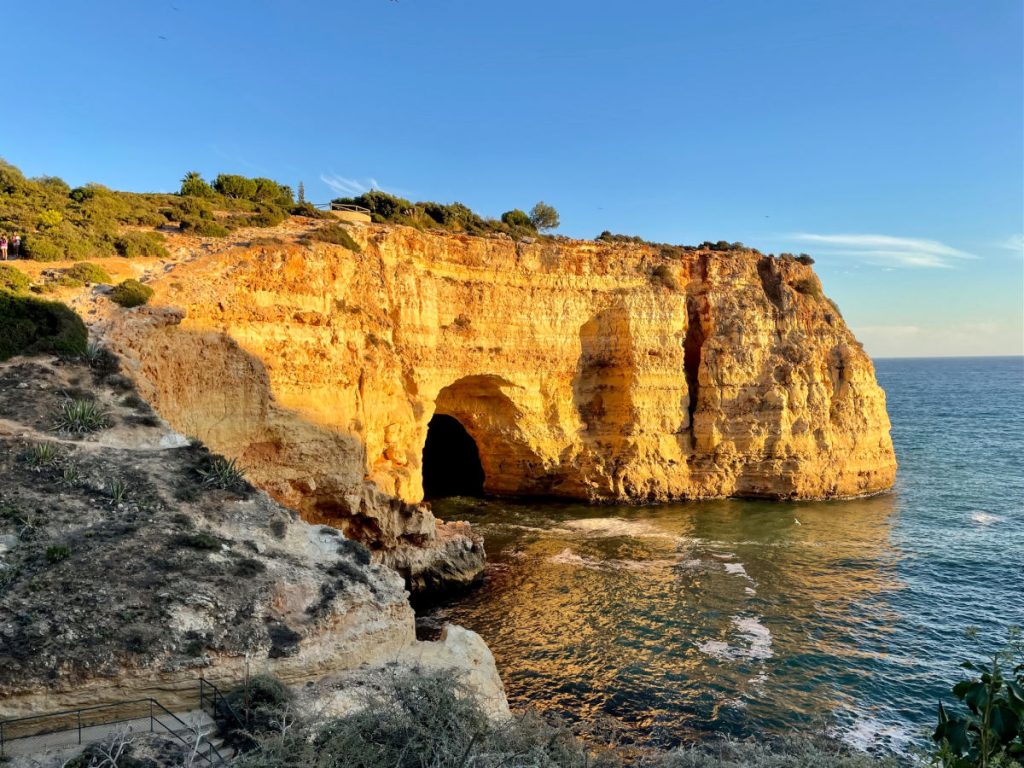
Once you’ve seen everything I listed for Lisbon, it’s now time to head south to the Algarve for some relaxation. If you have a rental car, it’ll only be a three-hour drive to pure beauty. If you want to take the train, you would take the Lisbon to Faro train to stay in either the Albufeira or Lagos area. Both are easy to get to via Uber or bus from the station.
The Epic Sana Hotel or the Pine Cliff Resort are both nice hotels, followed by the Martinhal Sagres Family Resort, which is a great family resort great for those with children.
The first thing you have to do is head out to the beaches. Algarve beaches are tucked between stunning sandstone cliffs on one of the most beautiful coastlines in Europe. The most famous tourist attraction is a boat ride to visit the Benagil Cave, but there are many ways to explore the coastline.
Albufeira and Lagos both have spectacular beaches and shopping and nightlife. There are little villages all over to explore. If you’re lucky, some sort of festival will be held downtown that is full of great music, food, and drinks. There’s always something to celebrate in Algarve. Two popular restaurants are Vila Joya and Bon Bon for fine dining.
Days 9-11: Seville, Spain
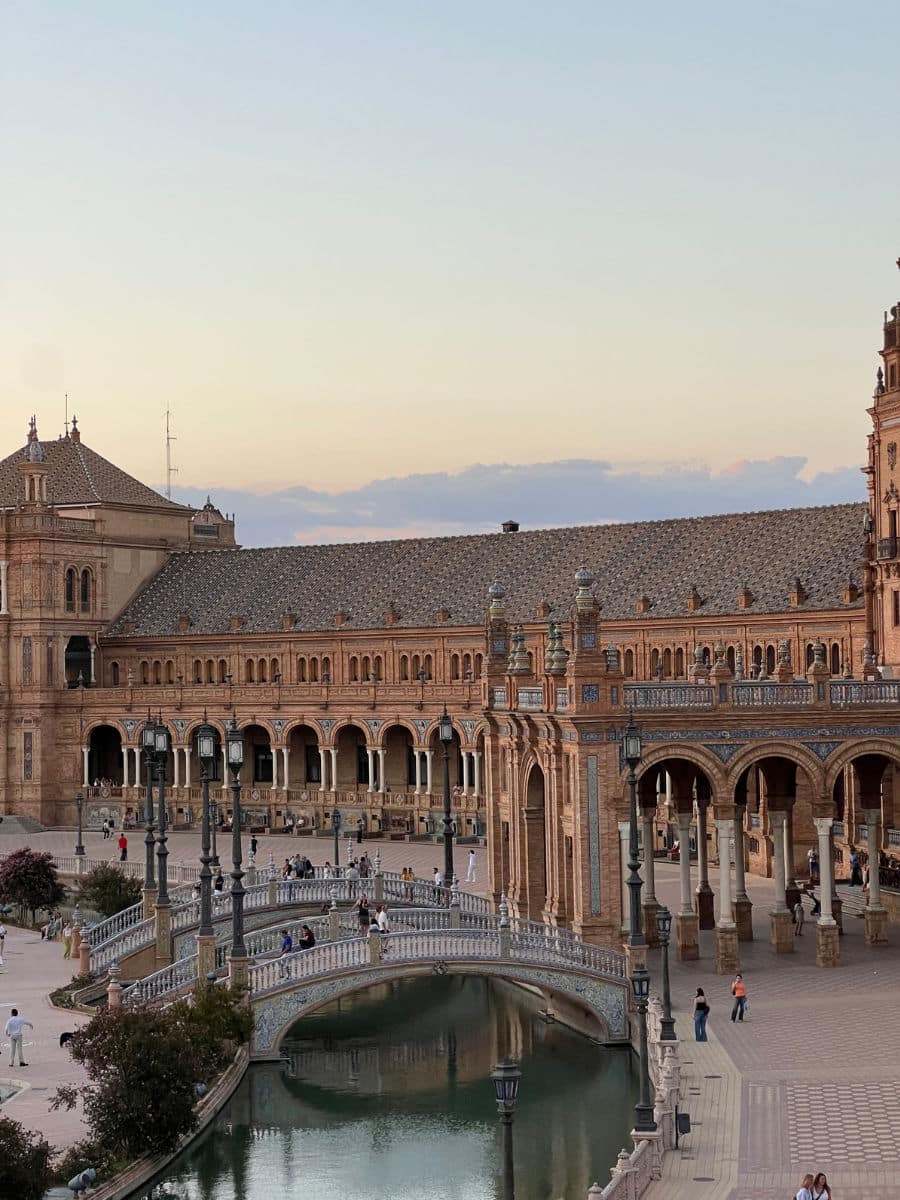
Enough relaxation, it’s time to get back into exploring and sightseeing and move on to Spain! The easiest way to get to Seville from Algarve is to drive or take a three-hour bus ride. Seville is the gateway to visiting the Andalusia region of Spain.
Choose to stay at either Hotel Alfonso XIII or Hotel Palacio de Villapanes. Both hotels are in the old town of Seville surrounded by history. Hotel Alfonso XII is the most famous hotel to stay at and has been around since the 1900s. The regal rooms and decor make this hotel stand out from others.
Since you’d already be in the city center, you should visit the Cathedral of Seville as well as the Royal Alcazar. The Royal Alcazar is a historical royal palace with beautiful tile work and stunning gardens, which have been featured in many films and shows.
From there, Seville’s beauty is often found just while wandering around. After living there for four months, my favorite places were the ones I stumbled upon, even just a favorite bench. The center also has hundreds of stores to choose from for clothes, shoes, and souvenirs. While wandering around, you can’t miss the Setas de Seville. This large wooden structure is the best way to see the city from high up, the views are unbeatable.
A 10-minute bus ride or 20-minute walk will take you to the Plaza de Espana. The Plaza de Espana is my favorite place in all of Seville. The square is beautifully built with authentic tiles all around.
The Maria Luisa Park is connected to the plaza and is a large garden made for lounging and relaxing with multiple fountains and benches. You’re able to rent a row boat to cruise on the river for an hour at your own pace or take a boat cruise.
Seville is also home to the famous dance of flamenco. There are multiple places that host flamenco performances, but you should have an authentic flamenco experience at a local restaurant. La Carbonería is a tavern with flamenco performances in an old coal warehouse. They have three flamenco shows every night, running from 8:30-10:30.
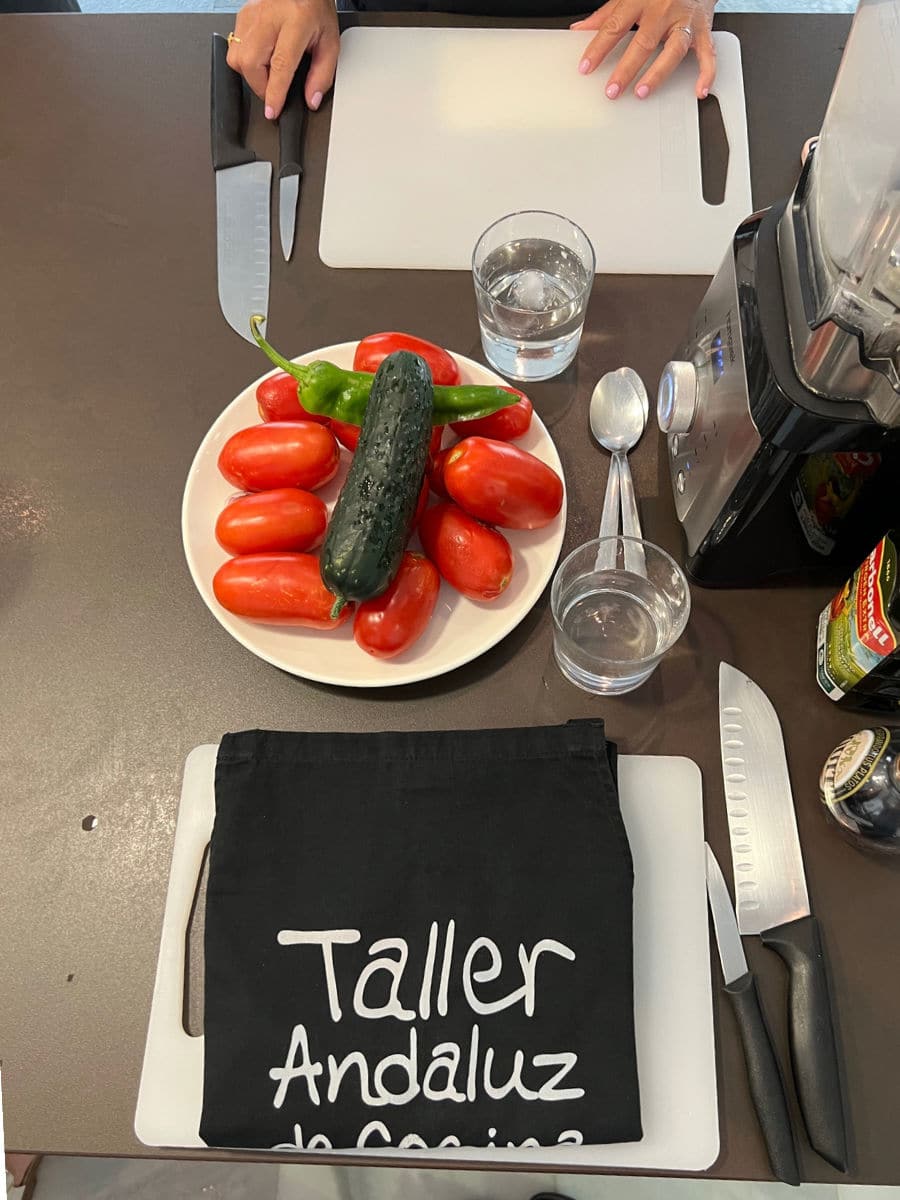
Another activity to do is a paella cooking class. The Triana Market is a fresh food market with vendor stalls selling produce, meat, and prepared meals. Within the market, Taller Andaluz de Cocina, hosts cooking classes and a tour of the market. The cooking class is held in a makeshift kitchen with everything you need. The class consists of three authentic Seville courses such as gazpacho, paella, and spinach and chickpeas.
The best restaurants in Seville are the Abantal, El Pinton, and Casa Manolo Lèon. Abantal is known for their fine dining with modern variations on Andalusian cuisines. El Pinton is well known tapas restaurant. Casa Manolo Lèon is my personal favorite, with authentic Andalusian cuisine and an outdoor patio filled with flowers and greenery.
Also see things to do in Seville with kids.
Days 12-14: Barcelona, Spain & Montserrat
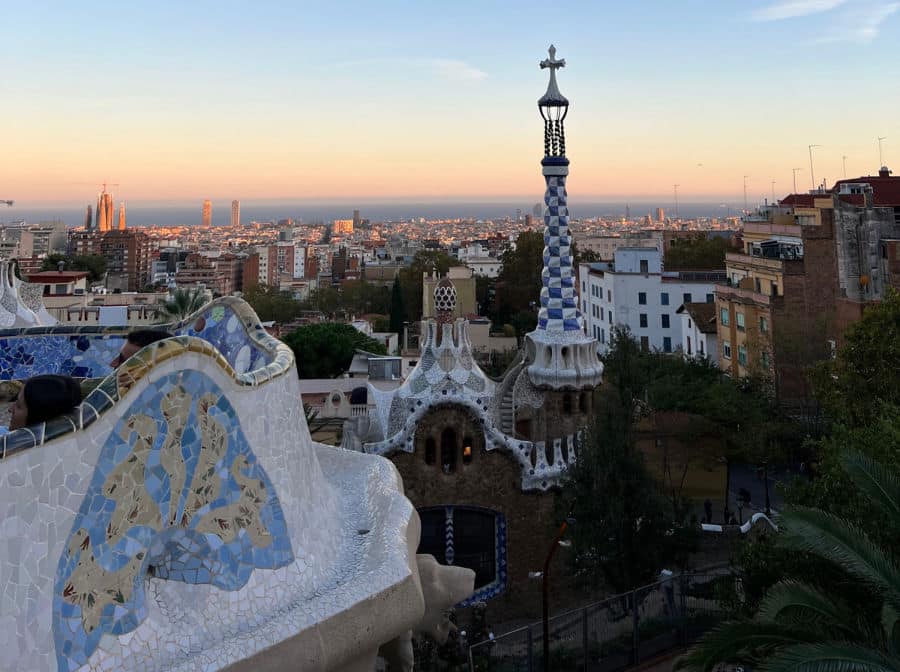
From Seville, take a quick flight to Barcelona for Spain’s most famous city. Hotel Neri and Ohla are my picks for your stay. Both are located in the Gothic Quarter. I personally recommend always staying in that area because it’s in the center of all the landmarks, shopping, and restaurants.
You’re able to walk around and get to any place if you stay there. From the Gothic Quarter you’re able to see the Cathedral and the Las Ramblas scenic area.
If you’re interested in art or architecture, you should book tickets to see the Gaudi houses. Casa Battló is one of Gaudi’s creations that we’re able to visit. The house belonged was lived in by Gaudi and his family. The design takes inspiration from the environment and its animals. Park Güell is an attraction I always go to when I’m in Barcelona. The park consists of Gaudi’s artwork within the framework and architecture of the gardens and buildings.
The following day, you should visit the Sagrada Família. When booking tickets for the Sagrada, you will have to do it relatively very early and also try to get skip the line passes. This is Barcelona’s biggest attraction, and it gets very crowded in there.
After spending a few hours in the Sagrada Família, I would take the rest of the day to walk around the Gothic Quarter. The last time I was in Barcelona, wandering around, I stumbled upon a fashion show at a park as well as a music video in the streets. This city is filled with vibrant energy and people, just appreciate what’s around you.
Barcelona is known for having some of the best restaurants. Disfrutar is considered as the top restaurant in Europe. Its experimental tasting menus are Mediterranean seafood based and more on the pricey side. Estimar is a hidden restaurant with an open kitchen view from your tabel. They’re known for their seafood and delicious seafood. If you’re tired of paella yet, Mana 75 specializes in paella and Catalan dishes.
On your last day before flying back home to the U.S., I recommend taking a day trip to Montserrat in the mountains. It’s the perfect escape from the intense city life you’ve experienced the last few days. Montserrat is known for its stunning mountain views, historic buildings, and hiking trails.
Also see things to do in Barcelona with kids.
Read more about Portugal and Spain
- One-week Portugal itineraries (4 options)
- Portugal trip planning tips
- How much does a trip to Portugal cost?
- 3 Days in Lisbon
- Things to do in Madrid with kids
- Day trip to Segovia
- Day trip to Toledo
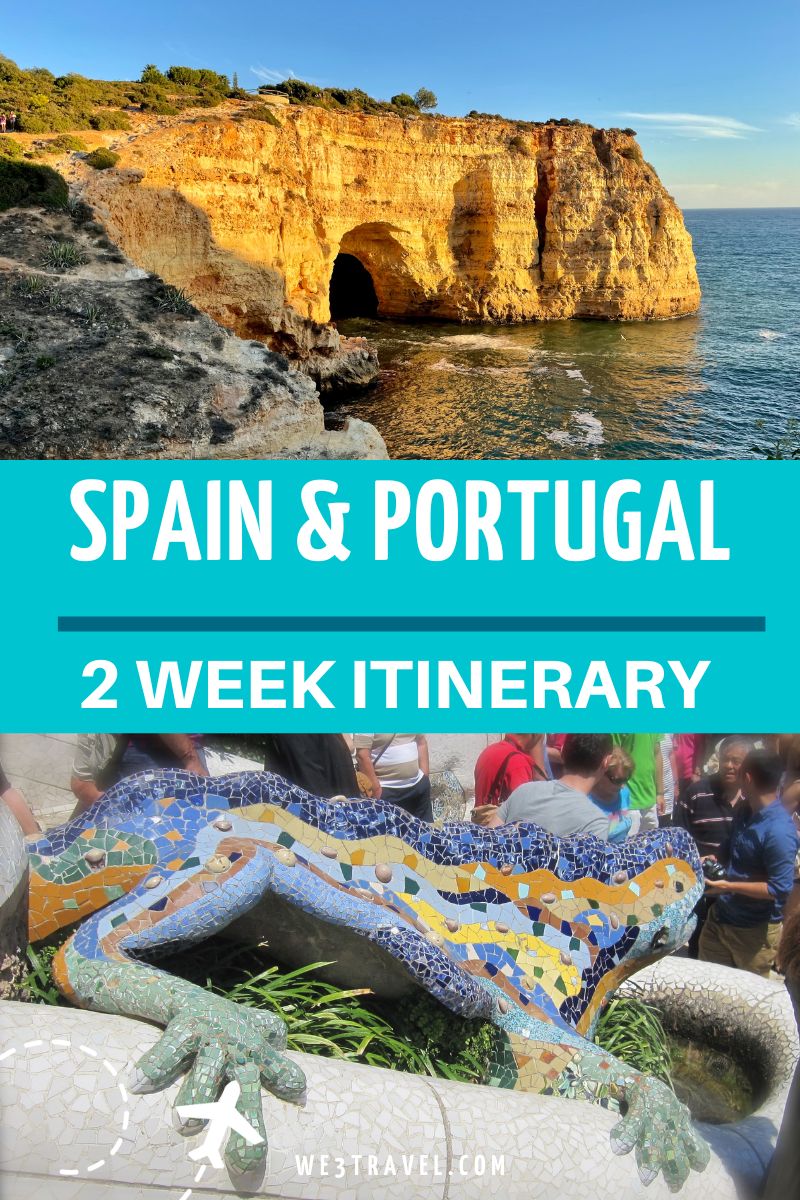

Emma Da Silva is a journalism major at the University of Rhode Island and an aspiring Travel Writer. Her love for photography and experience studying aboard have led her to want to write for other adventurers and inspire them to go out and make lasting memories.


